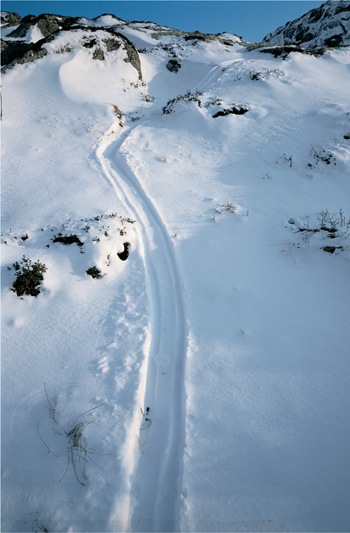
Lutra lutra
The Otter is a predator and always found near water, usually fresh water; hence, it can easily be confused with European Mink, which lives in the same habitats. The mink, however, is smaller and has a more pointed snout. The Otter’s body is streamlined, with a long, muscular tail. When an Otter is swimming, most of its body is beneath the water, but a mink swims considerably higher in the water. An Otter’s head is flat with a broad snout, long stiff whiskers, and small round ears.
The fur is brown, lighter below, and the Otter has a light brown neck and cheeks. A European Mink is brown-black and not discernibly lighter on the underparts. The Otter is about 60–80 cm long; the female weighs 5–8 kg, the male 6–12 kg. The tail is 35–45 cm long, about one-third the animal’s total length.

An Otter’s legs are short, with wide feet. The Otter swims fast, faster than beavers, muskrats, and water voles. It can dive for up to six minutes, but usually stays under water for no longer than one minute.
The Otter is solitary within its territory. The female’s territory is smaller than that of the male, and the latter might overlap that of several females. Males and females are found together only during mating season in spring.
In the winter, after the ice has formed, the Otter needs to find open water to hunt. SS.

The Otter is nocturnal throughout the year. During the day, it usually hides in hollows in embankments, under the roots of trees, and in other protected places. In coastal areas, however, it may also be active during the day.
The Otter has five webbed toes on each foot. The front footprint is elongated, often traces of the heel are also visible, and the full print is 7–9 cm long, the width about 6 cm. The hind footprint is almost circular, with a diameter of 5–7 cm. The webbing may not be noticeable, and the thumb is also rarely visible. The claws are very small and seen as small points in front of the toe-pad prints.
The Otter normally does not walk with a measured gait, but moves in a bouncy fashion. When the animal is moving at a normal pace, the distance between the groups of prints is about 40–80 cm. In snow or in soft mud, you can also see marks left by the dragged tail.
An Otter’s glide-path in the snow. AL.

Otters are lively animals. On steep embankments they often create deep ruts they use as glide-paths as they slide down the slope. In winter, these can be clearly visible in snow.
An Otter track with clear drag marks from the tail. SJ.

Otter tracks in snow with a wide rut left by belly and tail. PB.

An Otter’s feeding site, with empty mussel shells. HP.

Scat is used for territorial marking in dry vegetation. ET.

Otters feed mostly on fish about 10–15 cm long but may also consume crustaceans, small birds, and large insect larvae in the water, as well as mice and voles on land.
Small fish are consumed in the water, larger ones at feeding sites on land. At these spots you might also find the remains of meals, which are, however, often quickly eaten by other animals.
Otters scent-mark their territories with scat that is tarry and black and smells strongly of fish. The smell is slightly sweet and not so unpleasant as that of mink scat. Older scat is greyish and crumbles easily. The scat contains fish scales and bones, as well as the remains of crabs and insects, and is often left on stones or in clumps of grass.
An Otter consumes larger fish, here a wolf fish, on land. SS.
